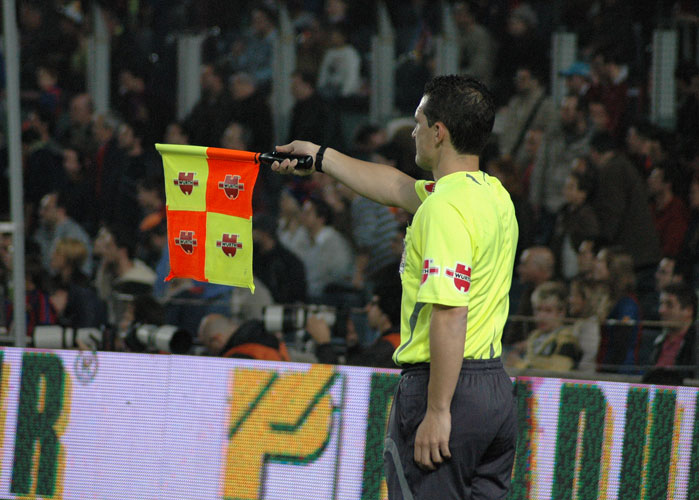
Just like any other sport, the team of officials in a soccer match can have a drastic impact on its tone and even its outcome. However, unlike many games, the soccer referees have a kind of organic, real-time control over the game, often with a certain freedom of interpretation and discretion. Most importantly, however, there is no instant replay for the refs, no matter how many times ESPN wants to show you a slow motion clip.
SOCCER OFFICIALS
The professional soccer matches you see on television will have a team of four referees on and around the field officiating.
The Referee (The Guy with the Whistle)

The referee is the only official on the field with the players. His is the final word during the game. And while he may consult with his three assistants, none of them may use video evidence of any kind to influence their decision. Ironically, this includes replays on a stadium's television.
The referee calls fouls and infractions, starts and stops play, keeps the official time for the game, and determines how much stoppage time is to be added at the end of each half. He can grant free kicks or penalties and he can caution a player with a yellow card or send a player off for the remainder of the game with a red card. When a player receives a red card, his team is forced to play the rest of the match with 10 men (or 9 men if two players receive a red card, 8 if three players do, etc.).
A yellow card is given for:
- Unsporting behavior (including simulating or faking a foul)
- Dissent by word or action
- Persistently infringing the laws of the game
- Delaying the restart of play
- Failing to respect the required distance of a corner kick or free kick
- Entering or re-entering the field of play without the referee’s permission
- Deliberately leaving the field of play without the referee’s permission
- Serious foul play (eg., a violent foul)
- Violent conduct
- Spitting at anyone
- A deliberate handling offense to deny an obvious goal-scoring opportunity by any player other than a goal keeper in his own penalty area
- Committing an offense that denies an opponent an obvious goal-scoring opportunity (eg., "professional fouls")
- Using offensive, insulting or abusive language or gestures
- Receiving a second caution (yellow card) in one game
One last note to make is that a referee does not have to immediately stop play when a foul has occurred. He can opt to allow play to continue if the team committing the foul would otherwise receive some sort of advantage (often defensive) from play being stopped. This is known as the Advantage Rule or Play On.
Assistant Referees (The Guys with the Flags)

The referee is accompanied by two assistant referees who occupy the opposite touchlines of opposite halves of the field. All of the assistant's decisions are advisory to the referee. He may use his flag to signify if a ball has gone out of bounds, if a foul has been committed, or if a player is in deemed to be off sides, but it is the referee who decides whether or not to stop play for any of those situations. For the most part, a referee will defer to an assistant referee in matters of off sides and balls going out of play.
Fourth Official (The Guy With the Lite Brite Board)

The fourth official acts primarily as an administrative assistant to the on-field referee. He ensures that substitutions (each team is allowed only three in a match) are carried out efficiently and communicates the amount of stoppage time on a lighted board. The fourth official may also act as an additional set of eyes for off the ball infringements or infringements that take place during confusing times of the match. For example, while the referee did not see Zinedine Zidane's infamous head butt during the 2006 World Cup final, the fourth official did and advised the referee in his decision to send off Zidane with a red card.
Tomorrow on Soccer 101: The Dreaded Off-Sides Discussion





1 comments:
Lolz. Ok, question for the masses: Why do the Ast Refs on the lines stand so stiffly? For that matter, why do refs in other sports stand so stiffly?? It's a power trip thing, right?
Post a Comment
Stateside Soccer reserves the right to delete any comment the staff deems to be offensive, profane or the result of spamming. Comments on posts older than a week are subject to approval.